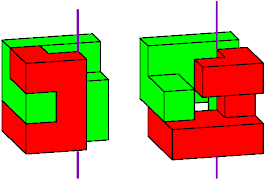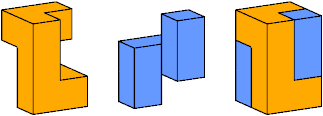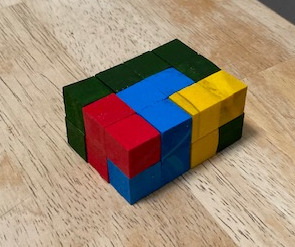
In the October
2001 issue of
Math Magic, Erich Friedman posed the problem of arranging
arbitrary polyominoes so that no group of polyominoes could be moved
relative to the polyominoes not in the group.
He called these Entangled Polyominoes.
Here is a similar problem for polycubes: for a number n, find the smallest rectangular prism polycube, or box, formed by n polycubes that cannot be separated.

But to separate the red piece from the green piece, we must move the red piece first down one cell, then back one cell, and finally right:

In this example, it is easy to remove the yellow piece:

But then the red piece can be separated from the green piece only by first rotating it around the axis indicated:

Edo is the world's resident expert on polycube tilings. For other remarkable polycube tilings, see his articles in issues 60 and 66 of Cubism for Fun, and this page at Greg Frederickson's website.
See also this entry in Lewis Patterson's blog Polyominoes.
Most of the known results for entangled polycubes were found by Yoshiyuki Kotani (小谷善行).
Most of the minimal solutions use the G pentacube:


This tiling is the only inseparable tiling of this box.

I believe that this tiling is also unique.

It is not unique. In fact, Professor Kotani points out that one cell of the pink piece may be transferred to the blue piece.
The smallest polycube need not have 3 cells. In this tiling, the smallest polycube has only 1 cell, at the center:

The smallest box by volume with 4 inseparable polycubes is 2×3×4:

I believe that this tiling is unique. Here is a model of it that I made from wooden cubes, glue, and paint:


This tiling is not unique.
Last revised 2022-10-05.